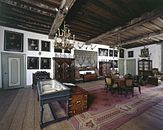
Maasdriel is a municipality in the province of Gelderland, in the eastern Netherlands.

Echteld is a village in the Dutch province of Gelderland. It is a part of the municipality of Neder-Betuwe, and lies about 6 km east of Tiel.

Vaassen is one of four villages in the Dutch municipality of Epe. Vaassen is situated between Apeldoorn and Zwolle, on the eastern edge of the Veluwe in the province of Gelderland. Vaassen was an independent municipality up to 1 January 1818, when it merged with Epe.

Maarten van Rossum was a military tactician of the duchy of Guelders who became field marshal in the service of Charles, Duke of Guelders. He was greatly feared outside his home country for the ruthless manner in which he waged war. In a long career, he often put his motto ""Blaken en branden is het sieraad van de oorlog" into practice. His way of waging war was quite similar to that of his Italian colleagues, the condottieri, and was characterized by guerrilla-like tactics, in which the civilian population was spared even less than was usual in his time.

Ter Worm or Terworm Castle is a castle located in the municipality of Heerlen, Limburg Province, Netherlands. The castle is part of the Terworm estate.
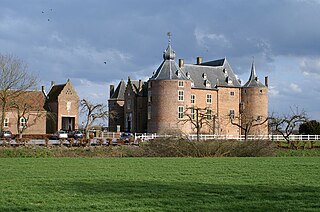
Ammersoyen Castle is located in Ammerzoden in the Bommelerwaard region in the province of Gelderland, the Netherlands. When the original construction of the castle occurred is unclear; some sources claim it was as early as the 12th century. However, the consensus among historians is that the Van Herlaer family completed the castle in the 1350s. At the time of its construction, the castle was built along a branch of the river Maas. Just a few years after the construction of the castle was completed, the river was rerouted leaving the castle to be surrounded by a moat.

Rechteren Castle is a Dutch castle situated on an island on side-branch of Overijsselse Vecht river, near the village of Dalfsen. It is the only castle in the province Overijssel from the Middle Ages that still exists.

Batenburg Windmill is a post mill in Batenburg, Gelderland, Netherlands which was built in the 18th century and is under repair as of February 2014. The mill is listed as a Rijksmonument.
Goudenstein Castle is a castle ruin in Haaften, a village in the municipality of Neerijnen in the Dutch province of Gelderland.
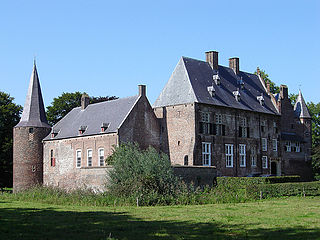
Hernen Castle is a Dutch castle from the 14th century.

Poelwijk Castle is an estate and former castle located to the south of the town of Gendt, part of the municipality of Lingewaard in the Dutch province of Gelderland. The moat and a residential tower of the castle have been preserved. The residential tower is a national monument.
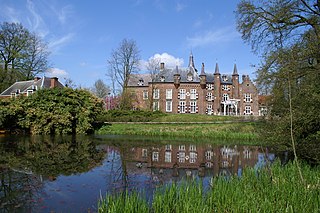
Maurick Castle is a castle in Vught, Netherlands. It had many famous owners and visitors.

Oud Herlaer was a castle on the Dommel just east of Vught. All that remains is a farm which incorporates parts of the old castle. While not that much remains of the castle, there are a lot of recent studies about Oud Herlaer and its owners. The farm is planned to be opened as an art center in 2021. The name Oud Herlaer,, signifies that later on Nieuw-Herlaer Castle was built about 1 kilometer upstream.

Waardenburg Castle, sometimes also called Weerdenburg, is a medieval castle located in Waardenburg in the municipality of West Betuwe, in the Dutch province of Gelderland.

Geldrop Castle is a castle with park near the center of Geldrop, North-Brabant, the Netherlands. It is on the edge of the valley of the Kleine Dommel.

Dussen Castle is a water castle that got its peculiar form after being destroyed by the St. Elizabeth's flood of 1421.

Oostende Castle is a castle in Goes, the Netherlands. The current castle was part of a motte-and-bailey castle. Its grounds formed the outer bailey. The motte was directly south of it, now under the Maria Magdalena Church.

The siege of Montfoort took place in 1280 when Count Floris V of Holland attacked the castle of lord Herman VI van Woerden at Montfoort in the Prince-Bishopric of Utrecht. The siege ended after half a year when the soldiers inside the castle surrendered. The primary source for the siege is the Rijmkroniek van Holland by Melis Stoke.

Castle Buren or Buren Castle was a princely residence in Buren in the Dutch province of Gelderland. The castle was one of the largest castles in the Netherlands. It was the seat of the Buren branch of the Egmond family, as well as of the House of Orange. It has been demolished in the 19th century. Today, not much remains except a monument in the former bailey of the castle as well as model in the local museum.
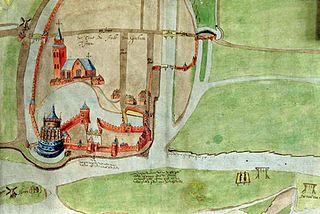
The Blue Tower was a castle with an imposing stone keep in Gorinchem, the Netherlands. It was a princely residence of Charles the Bold, Duke of Burgundy. The complex, which stood there between 1461 and 1578, gained an almost mythical status thanks in part to descriptions by the Gorinchem chronicler Abraham Kemp and the discovery of its foundations in 1983.




